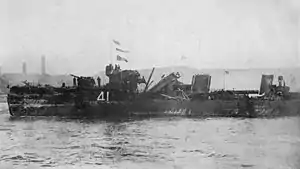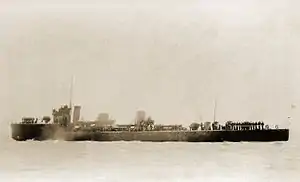Acasta-class destroyer
The Acasta class (in September 1913 re-designated the K class) was a class of twenty destroyers built for the Royal Navy under the Naval Programme of 1911 - 1912 that saw service during World War I. They were the last class of Royal Navy destroyers to have mixed names with no systematic theme (see naming conventions for destroyers of the Royal Navy for more information.) When the class was designated as "K", names beginning with that letter were allocated to the ships but never used.[Note 1][4] The class saw extensive wartime service and seven were lost, including four at the Battle of Jutland.
.jpg.webp) HMS Shark | |
| Class overview | |
|---|---|
| Name: | Acasta class |
| Operators: | |
| Preceded by: | Acheron class |
| Succeeded by: | L class |
| Built: | 1912–1913 |
| In commission: | 1912–1923 |
| Completed: | 20 |
| Lost: | 7 |
| General characteristics | |
| Type: | Torpedo boat destroyer |
| Displacement: | 934 to 984 tons |
| Length: | 267 ft 6 in (81.53 m) to 252 ft (76.8 m) |
| Beam: | 26 ft 6 in (8.08 m) to 26 ft 9 in (8.15 m) |
| Draught: | 9 ft 6 in (2.90 m) to 9 ft (2.7 m) |
| Installed power: | 24,500 hp (18,270 kW) |
| Propulsion: |
|
| Speed: | 29 kn (53.7 km/h) - 32 kn (59.3 km/h)[1] |
| Complement: | 75 - 77 |
| Armament: |
|
Design
The Acastas were larger and heavier armed than the preceding H and I classes (Acorn and Acheron, respectively), displacing about 25% more and with the mixed calibre armament replaced with a uniform fit of QF 4-inch guns, which the Acastas introduced. Previous 4-inch (102 mm) weapons had been of the breech-loading (BL) type. The 4-in guns were shipped one on the forecastle and one at the stern, as in the Acheron class, while the third was variously sited on the centreline between the two torpedo tubes or abaft both.[5] All ships had three funnels, the foremost being tall and narrow, the second short and wide and the third level with the second but narrower. The foremost torpedo tube was sited between the second and third funnels, a distinctive feature of this class.
There were twelve 'standard' vessels built to a common Admiralty design,[1] and eight builders' specials that (except for Garland) had a shorter, less beamy hull; five of the latter were from Thornycroft with 22,500 shp (16,800 kW) (one of Thornycroft's ships, Hardy, was planned to diesel cruising motors, but these were not ready in time and Hardy was completed with Thornycroft's standard machinery).[6] One by Parsons (Garland) had semi-geared turbines[7] giving a speed of 31 knots (57 km/h; 36 mph) on trials, with a seventh from Fairfields had a clipper bow. The eighth 'special' was Ardent by William Denny, Dumbarton, which was built using longitudinal framing rather than conventional transverse framing. While Ardent's novel construction seems to have been a success, no more destroyers were built for the Royal Navy using longitudinal framing until the J-class destroyers in the 1930s.[7][8]
Service
At the outbreak of World War I until mid-1916, the Acastas were serving in the Grand Fleet as the 4th Destroyer Flotilla, with Swift as leader. By the time of the Battle of Jutland the leader was the Faulknor-class flotilla leader Tipperary, with Ardent, Fortune, Shark and Sparrowhawk lost in the course of the battle[9] and Acasta was so badly damaged that she had to be practically rebuilt. After Jutland the remainder of the flotilla moved to the Humber and then to Portsmouth by the end of 1916, before dispersing, some ships to the 6th Destroyer Flotilla and the Dover Patrol and the remainder to Devonport. All survivors of the war were sold out of service for scrapping by 1921.
Ships
Admiralty K class
| Name | Ship Builder[10] | Laid down[10] | Launched[10] | Completed[10] | Fate |
|---|---|---|---|---|---|
| Acasta | John Brown & Co., Clydebank | 1 December 1911 | 10 September 1912 | November 1912 | Sold for breaking up 9 May 1921.[11] |
| Achates | John Brown | 15 January 1912 | 14 November 1912 | March 1913 | Sold for breaking up 9 May 1921.[11] |
| Ambuscade | John Brown | 7 March 1912 | 25 January 1913 | June 1913 | Sold for breaking up 6 September 1921.[11] |
| Christopher | Hawthorn Leslie & Co., Newcastle | 16 October 1911 | 29 August 1912 | November 1912 | Sold for breaking up 9 May 1921.[11] |
| Cockatrice | Hawthorn Leslie | 23 October 1911 | 8 November 1912 | March 1913 | Sold for breaking up 9 May 1921.[11] |
| Contest | Hawthorn Leslie | 26 December 1911 | 7 January 1913 | June 1913 | Torpedoed and sunk by German U-boat in the Western Approaches 18 September 1917.[12] |
| Lynx | Harland & Wolff, Govan | 18 January 1912 | 20 March 1913 | January 1914 | Mined and sunk in Moray Firth by mine laid from German raider Meteor 9 August 1915.[12] |
| Midge | Harland & Wolff, Govan | 1 April 1912 | 22 May 1913 | March 1913 | Sold for breaking up 5 November 1921.[11] |
| Owl | Harland & Wolff, Govan | 1 April 1913 | 7 May 1913 | April 1914 | Sold for breaking up 5 November 1921.[11] |
| Shark | Swan, Hunter & Wigham Richardson, Wallsend | 18 October 1911 | 30 July 1912 | 3 April 1913 | Disabled by gunfire and torpedoed and sunk at Battle of Jutland 31 May 1916.[12] |
| Sparrowhawk | Swan, Hunter | 25 October 1911 | 12 October 1912 | 2 May 1913 | Collided with HMS Broke at Battle of Jutland and torpedoed by HMS Marksman 1 June 1916.[12] |
| Spitfire | Swan, Hunter | 20 December 1911 | 23 December 1912 | 19 June 1913 | Sold for breaking up 9 May 1921.[11] |
K-class Builders' specials
| Name | Ship Builder[10] | Laid down[10] | Launched[10] | Completed[10] | Fate |
|---|---|---|---|---|---|
| Ardent | William Denny & Br., Dumbarton | 9 October 1912 | 8 September 1913 | February 1914 | Sunk by secondary gunfire from German dreadnought SMS Westfalen at Battle of Jutland 1 June 1916.[12] |
| Fortune | Fairfield, Govan | 24 June 1912 | 17 May 1913 | December 1913 | Sunk by secondary gunfire from German dreadnought SMS Westfalen at Battle of Jutland on night of 31 May / 1 June 1916.[12] |
| Garland | Parsons Turbine, Wallsend (hull sub-contracted to Cammell Laird, Birkenhead) | 15 July 1912 | 23 April 1913 | December 1913 | Sold for breaking up 6 September 1921.[11] |
| Hardy | Thornycroft, Woolston | 13 November 1911 | 10 October 1913 | September 1913 | Sold for breaking up 9 May 1921.[11] |
| Paragon | Thornycroft | 14 March 1912 | 21 February 1913 | December 1913 | Torpedoed and sunk by German destroyer in action in the Straits of Dover 18 March 1917.[12] |
| Porpoise | Thornycroft | 14 March 1912 | 21 July 1913 | January 1914 | Sold 23 February 1920 back to Thornycroft for resale to Brazil; became Brazilian Alexandrino Deaenca, later Maranhao.[11] |
| Unity | Thornycroft | 1 April 1912 | 18 September 1913 | March 1914 | Sold for breaking up 25 October 1922.[11] |
| Victor | Thornycroft | 1 April 1912 | 28 November 1913 | June 1914 | Sold for breaking up 20 January 1923.[11] |
 HMS Spitfire showing damage sustained at Jutland
HMS Spitfire showing damage sustained at Jutland HMS Ambuscade
HMS Ambuscade.jpg.webp) HMS Hardy at speed
HMS Hardy at speed.jpg.webp) HMS Ardent
HMS Ardent HMS Contest
HMS Contest
Notes
- No class of ships were designated as J class.
References
- "K-class destroyers (extract from Jane's Fighting Ships of 1919)". Archived from the original on 7 September 2006. Retrieved 27 February 2009.
- H.M.S.O. (1916). The Sight Manual. Pub. No. OU 6026. p. 80. ADM 186/216
- March. British Destroyers, p. 127.
- Friedman 2009, p. 129.
- March. British Destroyers, pp. 125, 129, 130.
- Friedman 2009, pp. 126–129.
- Friedman 2009, p. 127.
- Brown 2010, pp. 70–71.
- ""Arrowsmith" List: Royal Navy WWI Destroyer Pendant Numbers". Retrieved 27 February 2009.
- Friedman 2009, pp. 306–307.
- "Destroyers before 1918". Battleships-Cruisers.co.uk. Retrieved 27 February 2009.
- "British Destroyer losses". Naval history.net. Archived from the original on 6 March 2009. Retrieved 27 February 2009.
Bibliography
- Brown, David K., The Grand Fleet: Warship Design and Development 1906–1922. Barnsley, UK: Seaforth Publishing, 2010. ISBN 978-1-84832-085-7.
- Maurice Cocker, Destroyers of the Royal Navy, 1893-1981, 1983, Ian Allan ISBN 0-7110-1075-7
- Friedman, Norman, British Destroyers: From Earliest Days to the Second World War, Barnsley, UK: Seaforth Publishing, 2009. ISBN 978-1-84832-049-9.
External links
| Wikimedia Commons has media related to Acasta class destroyer. |